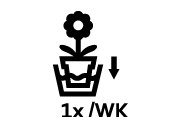Phalaenopsis
This plant species originates from South-East Asia, the Philippines and Australia. In the wild Phalaenopsis particularly grows in trees without drawing nutrients from the tree. In addition to trees, this orchid also grows wild in heavily aerated soil such as humus, and on rocks and in crevices, usually close to rivers and streams.
The discovery of the Phalaenopsis
The genus Phalaenopsis was described in 1825 by the Dutch botanist Dr. C.L. Blume, who worked at the Royal Botanic Gardens in Buitenzorg (now called Bogor) on the island of Java. The story goes that during one of his trips, he saw a group of butterflies floating almost motionless beside a tree. These turned out to be orchids, which he later called Phalaenopsis amabilis. ‘Amabilis’ means ‘charming’ and the genus name ‘Phalaenopsis’ means ‘like a moth’, derived from the Greek word ‘Phalaina’ (moth) and ‘opsis’ (resembling).
Where to buy a Phalaenopsis orchid
Phalaenopsis is available all year round from florists and garden centres and sometimes also from DIY stores and supermarkets. There are small-flowered species – also called multiflora – with a lot of small flowers as well as standard species. There are also large-flowered species – grandiflora – with flowers which are at least ten centimetres across. Phalaenopsis occurs in white, yellow, pink and purple and there are also species with unusually shaped and marked flowers.
Care tips
The right spot
The Phalaenopsis must be placed in a spot where there is sufficient light, but avoid direct sunlight, particularly in the summer months. If the leaves turn yellow this can be a sign of too much direct sunlight. The shedding of buds or dark green leaves points to a possible lack of light. Phalaenopsis also dislikes draughts, and the plant should not be placed right next to a radiator.
Temperature
Phalaenopsis is most comfortable at a temperature of between 20 °C and 22 °C. The minimum temperature is 16 °C and the maximum temperature is 32 °C. Phalaenopsis flowers for a long time: several weeks and often even months.
Watering a Phalaenopsis orchid
There are a few ways to water your orchid:
- Bathing: Put the roots of the orchid in a shallow bath for a short while (5-10 minutes). You can use a basin, a bucket or your sink. Leave the (plastic) inner pot in place to ensure that you don’t damage the roots. It’s also essential that the plant dries thoroughly after its bath because orchids don’t like wet feet.
- Dish of water: You can also water your orchid by immersing it in a dish filled with water. By placing the orchid with its (plastic) inner pot in a layer of water for 5-10 minutes, the roots will absorb the water they need. If you do this, make sure to let the orchid dry well.
- A shot glass of water: If you don’t have time or you can’t take the orchid out of its pot, the shot glass is the perfect tool for you. To give an orchid the exact amount of water it needs, you only need to pour one shot glass of water (around 60 ml) between the roots.
In the winter months when the heating is on, it is a good idea to spray the plant with water regularly in order to ensure that the humidity does not drop too low. Feed the plant about twice a month with special orchid food (in the water) between March and October. The Phalaenopsis can grow aerial roots outside the pot. Leave these roots in place: they are a sign that the plant is happy.
Read also: 3 ways to water your orchid
Making Phalaenopsis orchid bloom again
To get the plant to flower again you need to cut the branch off above the second ‘eye’. This is a thickening of the branch. Start by counting from below. You can prune the branch above the second eye twice, after which it is a good idea to cut the branch as low as possible.
After pruning give the plant less water – once every two weeks – and place it in a cooler spot. The ‘cooling’ will encourage the formation of new branches. After about two months the plant can be returned to its old place and return to normal watering – once every week. The plant can flower again after six months.
Read also: How to make orchids rebloom again?
 |
Be careful with the sun: these plants should not be placed in direct sunlight, as there is a risk of burning. A light spot where the sun does not hit directly is perfect. A north-facing window or a screen from the sun should be fine as well. |
 |
Immerse once per week: A potted plant with its pot in a tub of water indicates that this plant likes to be immersed with its root ball in the water for a short time (10 minutes). After immersion, make sure that the water is drained off. |
 |
(Orchid) Nutrition once a month: this plant has a moderate nutritional need. Feeding it once a month in accordance with the concentration recommended on the product is sufficient. |
 |
Minimum 15°C, maximum 25°C: the orchid feels at home in most living rooms. |
 |
Not suitable for consumption: these plants are not suitable for consumption by humans and animals. |
